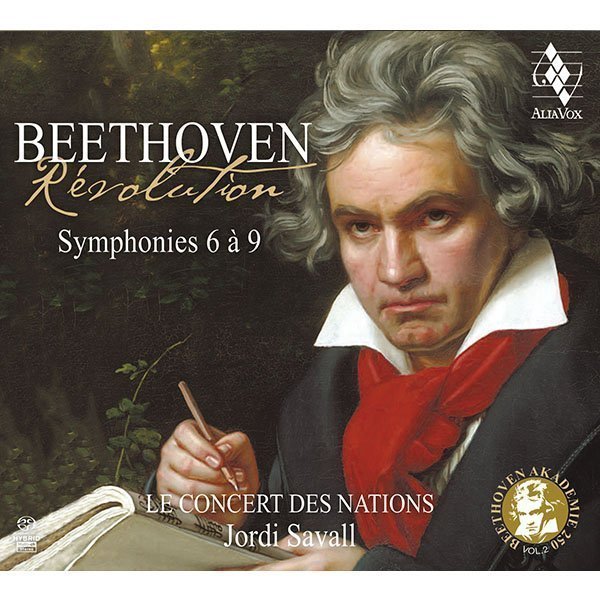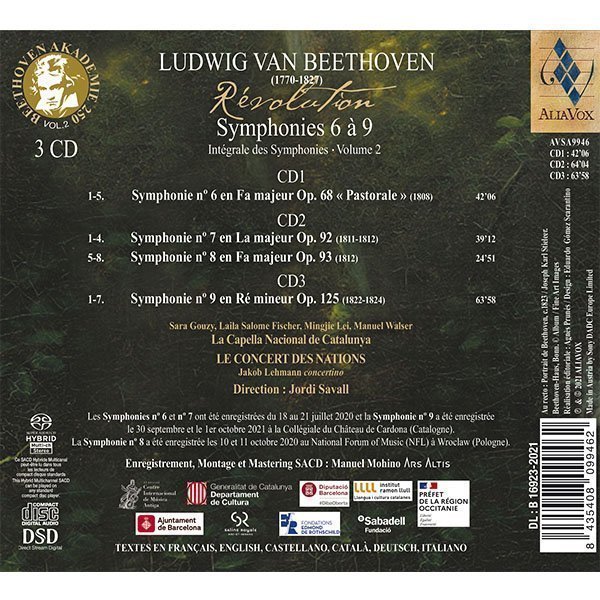BEETHOVEN Révolution
Symphonies 6 à 9
Jordi Savall, Le Concert des Nations
34,99€
ALIA VOX
AVSA9946
CD1 : 42′ 06”
CD2 : 64′ 04”
CD3 : 63′ 58”
LUDWIG VAN BEETHOVEN
(1770-1827)
Révolution
Symphonies 6 à 9
Intégrale des Symphonies. Volume 2
CD1
1-5. Symphonie nº 6 en Fa majeur Op. 68 “Pastorale” (1808) 42’06
CD2
1-4. Symphonie nº 7 en La majeur Op. 92 (1811-1812) 39’17
5-8. Symphonie nº 8 en Fa majeur Op. 93 (1812) 24’52
CD3
1-7. Symphonie nº 9 en Ré mineur Op. 125 (1822-1824) 63’58
Sara Gouzy, Laila Salome Fischer, Mingjie Lei, Manuel Walser
La Capella Nacional de Catalunya
LE CONCERT DES NATIONS
Jakob Lehmann concertino
Direction : Jordi Savall
Les Symphonies nº 6 et nº 7 ont été enregistrées du 18 au 21 juillet 2020 et
la Symphonie nº 9 a été enregistrée les 30 septembre et le 1er octobre 2021
à la Collégiale du Château de Cardona (Catalogne).
La Symphonie nº 8 a été enregistrée les 10 et 11 octobre 2020
au National Forum of Music (NFL) à Wroclaw (Pologne).
Enregistrement, Montage et Mastering SACD : Manuel Mohino
TEXTES EN FRANÇAIS, ENGLISH, CASTELLANO, CATALÀ, DEUTSCH, ITALIANO
Beethoven’s Symphonic Genius
A “heroic” adventure: finishing the complete cycle of Beethoven’s nine symphonies
during the time of the COVID-19 pandemic.
Finishing our project of the complete Beethoven Symphonies, which began with Symphonies 1 to 5 in 2019, was delayed in 2020 by the expansion of the COVID-19 pandemic. Nevertheless, and despite the numerous difficulties and complications due to the restrictions on gatherings in enclosed spaces and the mandatory health safeguards, we managed to go ahead with the 1st and 2nd Beethoven 250 Academies for Symphonies 6 and 7, which were held in July, 2020, as well as the 3rd Academy for Symphonies 8 and 9, held as planned at La Saline Royale d’Arc-en-Senans. The 4th Academy began on 6th October with work on the instrumental movements of Symphonies 8 and 9, and on 7th October we started rehearsing with the choir for the concert on 9th October and the recording. However, the day after 8th October, the day when we were due to start recording the Ninth with the choral parts of the 4th movement, we learned that four members of the choir had fallen ill with COVID-19. Once the initial shock had passed and we realised that we were seriously at risk of having picked up the infection, we were able to save the concert scheduled for 9th October, which was to have featured the Ninth, by playing only the three orchestral movements without the chorus, in the order 1, 3 and 2 (as had already been done in Beethoven’s day), as well as the Seventh Symphony. On 10th October, we were able to record Symphony No. 8, and on 11th October we all returned to our respective places of residence, after having taken PCR tests.
Unfortunately, the next day, the PCR test came back positive for some of us (myself included), which forced us to cancel all of the remaining concert tour scheduled for Paris, Barcelona, Hamburg, Milan, Turin, Rimini, Lisbon, etc. It was a real artistic and financial catastrophe (and also difficult from the point of view of our state of mind). Fortunately, for most of us, except two musicians who took longer to recover, the effects of the illness, apart from severe fatigue and complete exhaustion for three long weeks, did not have major consequences.
+ information in the CD booklet
JORDI SAVALL
Hamburg, 9th October, 2021
Translated by Jacqueline Minett
Critics
”
Wenn so musiziert wird, wie es Jordi Savall und Le Concert des Nations zelebrieren, ist es eine Lust, sich dem symphonischen Kosmos Beethovens hinzugeben.When music is celebrated as Jordi Savall and Le Concert des Nations are able to, it becomes pure pleasure to devote oneself to the symphonic cosmos of Beethoven.
PREIS DER DEUTSCHEN SCHALLPLATTENKRITIK,2022 (Orchestermusik und Konzerte)
”
Jordi Savall i Le Concert des Nations presenten "Beethoven Révolution, Symphonies 6 à 9".L'últim àlbum de la integral de les simfonies de Beethoven, sota la direcció de Jordi Savall, al capdavant de Le Concert des Nations, amb Jakob Lehmann, concertino, i, en la novena simfonia, amb La Capella Nacional de Catalunya i la soprano Sara Gouzy, la mezzosoprano Laila Salome Fischer, el tenor Mingjie Lei i el baríton Manuel Walser. És un àlbum triple que ha editat Alia Vox.
CATALUNYA RADIO, 29.03.2022
”
Much as I will always love Norrington’s trailblazing recordings and Krivine’s crisp, underrated set, Savall’s may well have just become my favourite period-instrument Beethoven cycle of them all.
Critics' Choice: our favourite classical albums of 2022 GRAMOPHONE. Mark Pullinger. 02/2022
”
A-t-on encore besoin de nouveaux enregistrements des symphonies de Beethoven ? S’ils sont marqués par autant d’intelligence, d’humanité, d’humilité et de calme passion entièrement mises au service d’une musique toujours neuve et surprenante, la réponse ne peut être qu’affirmative. Dans une approche historiquement informée mais sans vouloir démontrer quoi que soit, Jordi Savall et le Concert des Nations signent ici une version profondément satisfaisante de ces œuvres au sortir de la pandémie.
Prix Caecilia 2022 – prix spécial 'coup de cœur'Ludwig van Beethoven, Symhonies 6 à 9Mars 2023, Patrice Lieberman
”
Un Beethoven fougueux et renouvelé, parfaitement inscrit dans le sillage des musiques révolutionnaires.
RADIO CLASSIQUE. 24/02/22. Jérémie Bigorie
”
"Savall has given us a new, deeply considered, wonderfully vibrant and emotionally transforming set of the symphonies that is absolutely life affirming."David A. McConnell.
THE CLASSIC REVIEW. February 24, 2022
”
"Plénitude poétique et spirituelle. Nerf expressif, vitalité collective. Le BEETHOVEN captivant de Jordi Savall"
CLASSIQUENEWS.COM
”
"Résultat ? Un Beethoven fougueux et renouvelé, parfaitement inscrit dans le sillage des musiques révolutionnaires – il n’est pas anodin que le chef ait souhaité sous-titrer son intégrale « Révolution ». "Les Trophées de Radio Classique Jérémie Bigorie. Radio Classique, 24 janvier 2022
RADIO CLASSIQUE, Jérémie Bigorie.24 janvier 2022 (pdf)
”
"Following the first album’s template, speeds align with Beethoven’s metronome markings, guaranteeing some exciting and hurtling speeds, especially in symphonies seven and eight. Orchestral forces reflect the modest instrumental contingent usually used in Beethoven’s day, allowing for much increased textural clarity, more vivid colours too." ...
THE TIMESGeoff Brown. January 12, 2022. (pdf)
”
A stunning completion to a triumphant journey, and a compulsory purchase!“The existence of the second volume of Jordi Savall's "Beethoven Revolution" is genuinely a miracle.”
RATEYOURMUSIC.COMFanfare, January/February 2022








Share